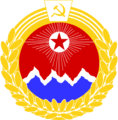Nation/Imperial Lyndonia and Montefalco
| This page is a work in progress by its author(s) and should not be considered final. |
| People's Republic of Imperial Lyndonia and Montefalco Po Tam je Imperaux Lyndenoi afas Mondefauko Vereinid in po Resjavik La Populara Respubliko de Imperia Lyndonio kaj Montefalco |
|||||
|---|---|---|---|---|---|
|
|||||
| Motto: "Paco kaj Prospeco por ĉiuj" "Peace and Prosperity for all" |
|||||
| Anthem: "Laŭdo al la Revolucio" "Praise to the Revolution" |
|||||
| Region | Flauxier | ||||
| Capital | Diascon D.D. | ||||
| Largest city | Laxtercon (Narschton) | ||||
| Official languages | Esperanto, English, Daux | ||||
| Demonym | Davantian | ||||
| Government | Socialist Republic under Semi-Presidential Democracy | ||||
| - | Great Leader Institution of the State |
Albert Quay (Soc-DP2) |
|||
| - | President Head of State |
Lucas Obrero (Soc-DP2) |
|||
| - | Prime Minister Head of Government |
Derell Guillory (Soc-DP2) |
|||
| - | Consul of Kraignow | Anakin Siegfried Quay CMP (non-partisan during incumbency) |
|||
| - | Speaker of the Pleinow | Sybille Nightingale Roux KMP (non-partisan during incumbency) |
|||
| - | Chief Justice of the Supreme Court | Eleonore Colette Thomas | |||
| Legislature | Blurschtriek | ||||
| - | Upper house | Kraignow (Hall of Councillors | |||
| - | Lower house | Pleinow (Hall of Keys) | |||
| History | |||||
| - | Founding | 983 B.C. (Lyndonia); 320 B.C. (Montefalco) |
|||
| - | United Kingdom of Lyndonia and Montefalco | 1458 | |||
| - | Republic of Davant and Enactment of Constitution | 27th March 1922 | |||
| - | Republic of Imperial Lyndonia and Montefalco (UFSI-led) | 27th March 1979 | |||
| - | Republic of Imperial Lyndonia and Montefalco (Soc-DP2-led) | 29th June 1998 | |||
| Area | |||||
| - | Total | 26.667 million km2 10.296 million sq mi |
|||
| - | Water (%) | 6.26% | |||
| Population | |||||
| - | 2017 estimate | 2,854,890,045 Mainland | |||
| GDP (nominal) | 2017 estimate | ||||
| - | Total | NS$ 901.937 quadrillion (DVκ 319 trillion) |
|||
| Gini (2018) | 0.00583 low |
||||
| HDI (2020) | 0.98 very high |
||||
| Currency | Davantian Karsk ( Karsk) (κ) |
||||
| Date format | dd ˘ mm ˘ yyyy | ||||
| Drives on the | left | ||||
| Calling code | 18 | ||||
| ISO 3166 code | ILAM | ||||
| Internet TLD | .lm | ||||
The People's Republic of Imperial Lyndonia and Montefalco (also known as ILAM) is a quasi-federal socialist republic under a semi-presidential democracy. It comprises three special administrative regions, two trust territories, eight provinces, and one autonomous district (the national capital). ILAM is the largest country in the Flauxier Continent in terms of land area, occupying most of the northern portion. The mainland territorial span of the country can be attributed to its historical roots to Imperial Lyndonia and Royal Montefalco.
History
Union of the Two Crowns (1458)
ILAM, before it became a republic, was once a kingdom. In 1458, the Great Collydorn War between the Empire of Lyndonia and Kingdom of Montefalco officially ended through a Declaration of Truce and Union. The declaration was made by King Liam VIII of Montefalco (later will be known as Liam the Great) and Grand Duke Bennet I of Lyndonia (later will be known as Bennet the Magnificent). The result of such declaration is the United Kingdom of Lyndonia and Montefalco ruled by two kings.
The Owl Revolt and the First Republic (1921/1922)
Several dynasties have interchangeably led the great Union. Due to familial controversies and some foreign intrusions, the administrative capability of the monarchy fell and the Royal Family weakened. The Knights of the Crescent Moon, who once protected King Liam I, led a series of revolutionary campaigns to reclaim what they called "the former glory of Liam's Union." Hence, the Owl Revolt was launched in December 1921 and a Provisional Government was established in January the following year. The leadership of the Provisional Government introduced the call for a Constitution Convention. In 27th March 1922, the Republic of Davant was proclaimed with the 1922 Constitution ratified overwhelmingly by the public.
Flauxier War and the Second Republic (1939/1941)
Party Dictatorship swept across the nation in the late 1920s. Growing cynicism was apparent in the citizens. Political anomalies were being uncovered and the bureaucracy severely weakened. Despite these, the Grand Party of Davant (GPD), whose founding members came from the Knights of the Crescent Moon, kept hold of the country and continued to rule until the Flauxier War in 1939. All Davantian males were drafted for the war, regardless of age. This move of the Government triggered a public outcry for Government overhaul and the banning of GPD.
The Subterranean Republic (1969)
After the fall of the GPD, a new populist Provisional Government was installed. The military and the coalition of political parties who helped in pushing for the ban against GPD convened as the People's State Council. All decisions are made in assembly. However, such system was later proven inefficient and ineffective. Due to the rising tension within the State Council, the United Front for Socialist ILAM (UFSI) broke away from the State Council and declared a state of war against the Provisional Government. UFSI vowed to destroy the "authoritarian, imperialist, capitalist, and feudalistic" council, declaring the Subterranean Republic.
The Parliamentarian Reform (1986)
The Provisional Government led by the State Council fell in 1976 following the Laxtercon Uprising. The Subterranean Republic of UFSI helped the rebels conquer the Government artillery in Bourton which eventually led to the decisive victory of the Socialist Campaign and the Laxtercon Uprising. In 1979, exactly a decade after the installation of Provisional Government, the The Republic of Imperial Lyndonia and Montefalco was proclaimed. In 1986, the UFSI succeeded in amending the 1922 Constitution; hence, the parliamentary reform was instituted. The new republic, which espouses Parliamentary multi-party democracy, is led by the UFSI since then.
The New Republic (1998)
Internal turmoil as to how socialism is to be implemented in the country led to eventual fall of the UFSI. In 1991, the UFSI leadership espoused "ideological purity" which led to the killing of thousands of Davantians and even foreigners who expressed dissent. Ideological Purity Tests were required before anyone can be admitted to schools and work. This system led to the rise of the number of out-of-school youth, the fall of literacy rate, and the Great Last Quarter Crisis of 1991. People died of famine, farmlands fell out of use due to drought, and factories closed down due to lack of workers who passed the ideological purity requirement. Such atrocities commited by the UFSI created a large dissenter group within the party itself. Albert Quay, the leader of this dissenter group, suddenly became a core personality of the struggle against the socialist-turned-authoritarian UFSI regime. Quay introduced his ideas and began campaigning for "true socialist governance." The people loved Quay and the term "Quayism" became a buzzword of the mid-1990s. The UFSI eventually collapsed and Quay's group suddenly found themselves at the helm of power. The group did not waste any time and started with their work immediately. With Quay's leadership, the Davantian People's Democratic Party worked for the abolition of the authoritarian laws passed by the UFSI and undertook the necessary action to reform the economy for true socialism.
Governance
The Government of Imperial Lyndonia and Montefalco, commonly referred to as The People's Government or ILAM Government, is the central government of The People's Republic of Imperial Lyndonia and Montefalco. The People's Government governs mainland ILAM and its satellite territories (3 special administrative regions and 2 autonomous regions). The Government is headed by the President as Head of State and the Prime Minister as Head of Government. The governing framework of the People's Government is the 1922 Davantian Constitution, as amended in 1998 and 2017. The primary feature of the Government is its type being semi-presidential where executive and legislative powers are fused. Interestingly, ILAM also practices a balance of centralization and decentralization making it a quasi-federal nation-state.
Structure
Political Situation
Territory
The National Capital
Provinces
Special Administrative Regions
Trust Territories
National Symbols
Flags of ILAM
Emblems of ILAM
Notable Figures
- Albert Quay, former paramount leader of ILAM; posthumously recognised as Eternal President until 2018 then as Great Leader.
- Leonid Ilyich, former President and Presidential Regent.
- Maximilian Sanders Baldwin, former Prime Minister and paramount leader; former Secretary of State, incumbent State Counselor.
- Lucas Obrero, former General Secretary of Soc-DP2; former Prime Minister; incumbent President.
- Derell Guillory, former opposition paramount leader during the Soc-DP2 crisis; incumbent Prime Minister.
- Lady Ara Pompei, heir presumptive (pretender) to the Imperial Throne; incumbent Deputy Leader of The Knights' Party (GPD).
- Sarah Lee, incumbent Leader of the Greens; known environmental biochemist; incumbent Minister of Environment.
- John Baxter, jazz singer and eccentric visual artist.
- Dr. Wynona Paladin, astrophysicist












